With lockdown clamped for major part of 2020 and travel restrictions in place, I was yearning for some solitude early this year. An escape from the stifling concrete jungle that we call home! The decreasing numbers of Covid cases in January 2021 gave me some hope that I could venture out. Desperate to move out and not wanting to expose the children to the virus, I had planned a solo trip along the North coastline of Tamil Nadu.
I had hired a car and was ready to leave on my solo trip early in the morning. Traffic was at normal pace, with the driver opting to travel to Tindivanam inland and from there branch out towards the coast. Seeking inner peace, I wanted to avoid crowded places. What would be a better place to sit back, think, and enjoy the solitude than the churches?
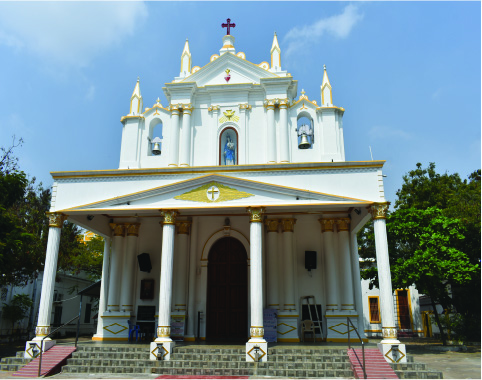
I had spoken with Mr Arockinathan, a retired professor of Pondicherry University and he had graciously agreed to take me around some quaint old churches of Pondy during the forenoon.
“You come straight to my home ma, let us then go from there to the churches. I will show you the best of them”, he chimed through the phone few days before my trip. Fun part was neither had I ever met him in person, nor did we have one on one communication other than in random facebook posts. From what little I knew, he taught Tamil to lot of international students and had penned a very important book- The Churches of Pondicherry. That was enough to pique my interest and request him to show me around the town.
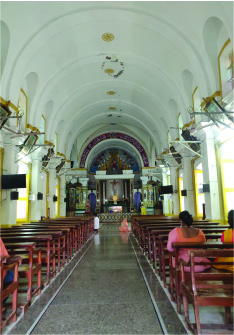
A quaint church amidst a maze of streets
Pondicherry has always been my ‘go to’ place for fun, but this time it was different. As the car pulled up in front of his house, he welcomed us cheerfully and immediately we left to the church close to his house, the Muthialpet Holy Rosary Church. Said to be one of the oldest parts of Pondicherry, Muthialpet is like a maze. A literal choc-a-block town of narrow streets and boulevards snake around a quaint church.
A beautifully whitewashed and clean, yet old church welcomed us. At the compound wall, Arockinathan showed me the plaques that he helped erect. One was a list of priests who had worked there and the other a dateline of important events centered around the church. The church was functioning from a small thatched shed from 1863. Pondicherry was a beautiful French town by then, with a handful of European Missions continuing their work in christening people. The French were staunch Latin Rite supporters and carried on the religious work with as much enthusiasm as the colonising work. Fr. Guyon Pierre had laid the foundation stone of this church in 1873 and it was completed in 1886. Intermittent droughts and natural calamities delayed the work of the church building. It was consecrated on 25.12.1886 by Fr Jules Mette.
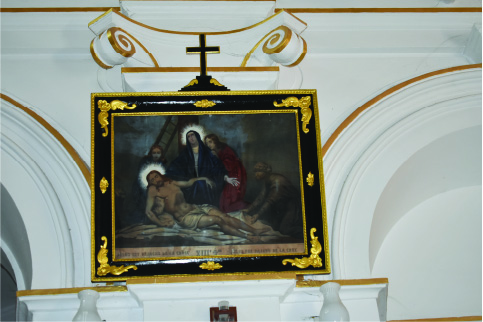
The dome of the old churches served two purposes. One, they offered lot of ventilation owing to the height and light, owing to the stained glass fixed on the domes and also played vital role as sound amplifiers. Most of the old churches have huge domes that can carry the sound from the altar to almost all parts of the church. Built in the usual cross shape of the past, the church has large doorways on all three sides and a Sacristy behind the altar. The Corinthian pillars and arches inside the church give one a nice old age feel. One side of the church has an elevated platform for the choir to perform. The Way of the Cross paintings kept in the church have descriptions written in French, another gentle reminder about the French Colony.
I pick a song leaflet left on the benches. It has lyrics of a couple of hymns to be sung in a ‘requiem mass’. All of them are in Tamil except for one which was transliteration of the Latin Hymn “Libera Me Domine”, the Gregorian chant.
Quite surprised, I ask Arockinathan, “Sir, who sings in Latin here?”. “Oh most of us do…our death masses definitely have Libera Me. Our people believe one goes to Heaven only if that chant is sung in Latin!”, he exclaims.
The love for the teenaged saint
Our next stop is the famed “Notre Dame Des Anges” church, or in Tamil simply the “kapskoil”. A beautiful edifice facing the beach, this church was built by the Capuchin Fathers and hence the name. As I get down from the car and march to the church, Arockinathan stops me and points to a statue placed in a small park facing the church. The marble statue of a woman, holding aloft a flag with pride stares back at me. Without a clue as to who it might be, I turn to Arockinathan. “She is Joan of Arc”, he beams. Another surprise, I never knew Joan of Arc had a statue in Pondicherry!
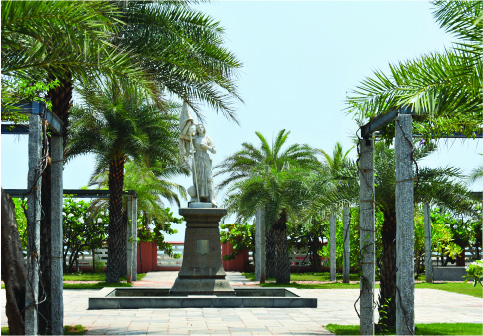
One of the nine patron saints of France and now a Saint canonized by the Roman Catholic Church, Joan gave the French a mighty push during the 100 years War with the British. She was 19 when she was captured and burnt at the skates in 1431. But her success in the siege of Orleans helped King Charles VII’s consecration. She is venerated by the French as their “Jeanne d’ Arc”; she is an embodiment of bravery often looked up to by women. Her meteoric rise from a common uneducated peasant girl to a woman who fought with vigour in the bloodiest battles endeared her to the French and the statue now stands at Pondicherry beach, overlooking the Notre Dame church in her honour.
“Do you know they never allowed us inside for a long time?”, asked Arockinathan. He recounted how the Capuchin Fathers never allowed dark skinned Indians anywhere near the church. It was an all French affair. Even today the Notre Dame has masses in French. The lettering “Domus Dei” (House of God) welcomes us as we climb up the porch steps.
A tall, resplendent Gothic architecture church with arched ceiling, splendid Corinthian pillars, arches, huge, colourful stained glass windows, antique furniture and marble flooring, the church does have an old world allure. Here too the Way of the Cross wood panels have French headers. We sit quietly for some time, with bowed heads. There is such warmth and quiet enveloping me, as I sit listening to sparrows chirping merrily on the orange flame flowering Palash trees.
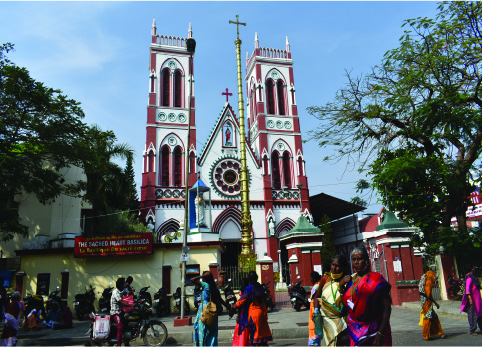
Here time stood still
We got back to Arockinathan’s house for a quick lunch, after which I bade him goodbye and walked out for the afternoon exploration. Busloads of tourists throng the Sacred Heart Basilica- La Basilique Du Sacre Coeur. Wary of the crowds most of them unmasked, I sanitize my hands once again, don the mask and alight from the car. At the entrance above the doorway the Latin phrase “sanctificavi locum istum, ut sit nomenmeumibi” which means “I have consecrated this house that my name may be there forever. My eyes and my heart will be there forever”, is etched. The plaque announcing the Basilica as minor basilica is displayed right in front of the church. The imposing Gothic edifice painted in red and ochre looks inviting as I walk in. Tall pillars, arches and stained glass windows welcome me in. Construction of this church started in 1902 and the church was consecrated in 1908.
Despite the crowd trailing in and out the church, the calmness is soothing. I admire the baptistery as I walk in. Sitting back, I take in the patterns on the floor formed by light streaming through bright coloured stained glasses. The nave is broad, the reredos of Joseph and Mary on either side of the altar have remarkable wood work. The tabernacle is hoisted on a beautiful white and gold apse. The stained glass murals of Saints adorning the side walls capture my interest. I find another Joan of Arc painted glass here too. The French do have lots of love for the teenaged Saint! Time is at standstill here. As I ventured out, I saw a couple buy baby dresses from the church stall.
“Why are you buying kids wear from the church stall?”, I enquire the lady and she shylyreplies she is expecting a baby and believes her prayers with this dress worn by Baby Jesus statue in the church will save her child. “Once the baby is born, we will don her with this dress”, she quips. I was reminded of my cousin who is expecting a baby and I too dash into the stall to buy a dress. During Christmas, it is said lot of such expecting mothers/new mothers buy baby dresses to adorn the Baby Jesus as their offering. The church puts these once worn dresses for sale and the money so received is set back as offering money. I bought a white dress, unaware of my cousin’s baby’s sex. It was by pure instinct that I bought it and as I look at it awaiting its new owner, I am sceptical if my cousin would even understand the faith behind it.

We reach Nellithope, another part of the town that had active Christian presence from 1840s. The first seminary for Indian priests “Le Petit Seminaire” had its beginnings here and so did Roman Catholic evangelisation of North Tamil Nadu. Originally said to be a gooseberry garden, the land for the Assumption Church was donated by Madame Jeanne Dupleix, the wife of Joseph Marquis Dupleix, the then Governor General of French India. Said to have been built in 1750, the new structure in place was consecrated in 1851.
A group of women clad in saffron sarees sit singing and praying, a Friday tradition of lent days. I sit quietly, taking in the beauty before me, the devotional altars to either side of the altar have mural work. The stained glass paintings of the Holy Family, Peter and Paul look astounding. The painting of Assumption Mary at the back of the church has the classic Renaissance look. Despite the fans whirring above, the heat is oppressive and I take refuge under the cannon ball tree just outside the church. The prayers of the women keep reverberating as I relish the fragrance of cannon ball flowers, my eyes feasting on a navy blue saree clad Mother Mary statue holding a blue frock wearing Baby Jesus, in an alcove outside the church.

The next stop of the day was a huge let down. I was expecting to see an ancient edifice; I was so looking forward to visit the 300 year old Our Lady of Health Church. What stood in front of me was a front porch elevation renovated in 2004. The original structure must have been demolished long back. The ceiling is still asbestos and I could feel profuse sweat breaking a few minutes inside the church. Yet, women sit here, calm and quiet, one in a bench, silently praying, and some shedding silent tears. I move outside quietly and am surprised to see the original dome of the church propping up from under the asbestos sheets. There is a small shrine for St Antony to the right of the church. I loiter around the graveyard nearby, trying to look out for any old graves and spot one with Tamil inscription.
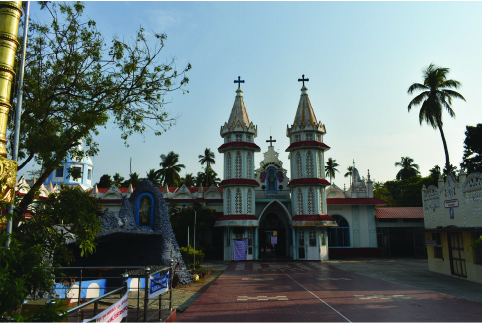
Faith, hope and love
The last stop of the day however lived up to its expectations — the St Andrew’s Church in Reddiyarpalayam area, another wonderful Gothic architecture church. The large area around the church with trees, birds and quiet looked alluring. This church is one of the oldest churches of Pondicherry, originally built in 1745 by Pedra Kanagaraya Mudali, the longest serving Dubash of the French East India Company. Kanagaraya Mudali lost his only dear son Belavendra Mudali, a young man of 21 years. In memory of his son, Kanagaraya built St Andrews Church and held its consecration on November 30, 1745. The famed Pondicherry chronicler Anandarangam Pillai notes in his diary that the consecration feast was attended by people from across all caste backgrounds. Kanagaraya served a meal for everyone irrespective of their caste, something unheard of during those times. It is said that the old church was demolished in 1761 and the new church was built in 1800s.
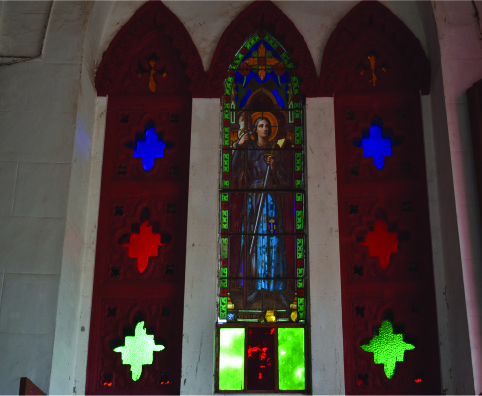
Unfortunately, Kanagaraya died the very next year and is buried in the precincts of the Church, in a vault where his son was buried earlier. One of the oldest Christian Tamil inscriptions is found in the vault. The relief work in the porch of the old church has images of vines, birds and sun. A small cupola is to the right of the church that has memorial plaques of priests who had served in the church. A completely broken chariot lies in shambles along the wilderness around the church and I sit outside in a bench watching the sunset, listening to the birds returning home.
Great churches are built by great people, in memory of those dead and gone, I tell myself. Kanagaraya’s son will be remembered along with the Church he built and so will be Joan of Arc who intently watches the “kapskoil” from the promenade. The way those alive mourn/venerate their dear departed is going to be the same. With the virus on a killing spree, all I can pray and wonder is, “will there be another travel to reminisce and write?” Grateful for what I was able to ponder upon in the midst of the lockdowns.

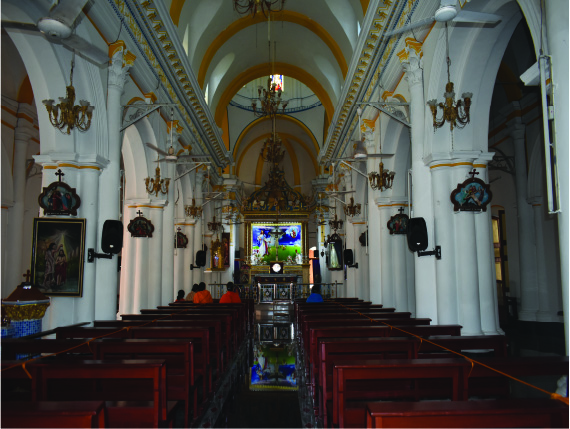
 [/column]
[/column]